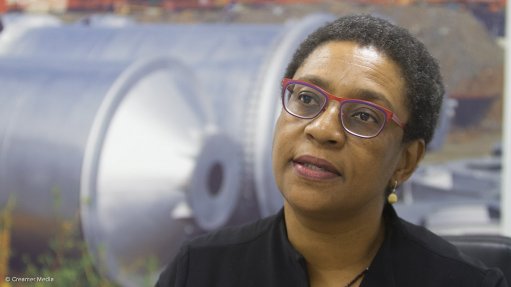
Zanele Matlala
Photo by: Creamer Media
The board of JSE-listed Merafe Resources has decided against declaring an interim dividend owing to prevailing market conditions; however, CEO Zanele Matlala on Monday noted that a final dividend would be considered based on the full-year results.
“In the absence of any opportunities, we will continue returning cash to shareholders in line with dividend policy,” she explained in a conference call following the release of the company’s results for the six months to June 30.
“Had we applied our guidance, we would have had R50-million to distribute which would be 2c a share, but at every dividend decision point, we have to look at what the future holds . . . we took a conservative approach that rather than pay a dividend at interim when you can’t quite tell what the next six months are going to look like . . . delay the decision. . .”
Matlala added that working capital did not unwind partly because Merafe was building up stocks for the winter.
“In June, we started cutting back production. By the end of the year, we should reduce from the levels we’re currently at, which will make the dividend decision easier.”
She noted that Merafe had previously guided that production would be in line with capacity utilisation of 85%, but, given the weaker pricing, Merafe decided to cut back further to about 80%.
Additionally, the 80% utilisation target is provisional as Merafe will be “pragmatic” when considering the state of the market, so further production cuts have not been ruled out.
MARKET
“Global uncertainty continues to impact negatively on markets and inflationary pressures persist for South African producers,” Matlala commented.
Merafe noted that, while global stainless steel production growth had remained positive during the first half of the year, global growth had been trending lower largely owing to macroeconomic uncertainty – one of the primary drivers being the US/China trade war.
Merafe noted that, during the interim period, the slight growth in ferrochrome demand growth was more than offset by global production, which increased by 7.9% to 7.1-million tonnes.
The majority of this production growth occurred in China where overall first-half production increased by 22%.
Moreover, ferrochrome exports from key producing regions such as South Africa and India, increased during the period.
Additionally, Merafe notes that “ample availability” of chrome ore supported the growth in Chinese ferrochrome production, with Chinese chrome ore imports having totalled 7.4-million tonnes for the first half of the year.
However, Merafe pointed out that the ferrochrome production rates had not been matched by ferrochrome demand within China, leading to an implied increase of Chinese ferrochrome stocks over several months, resulting in a significant decline in prices.
Matlala commented that production cuts were expected to be implemented in key markets and that current ferrochrome surpluses were likely to narrow or reverse within the next year or so, after which the market should respond with pricing increases.